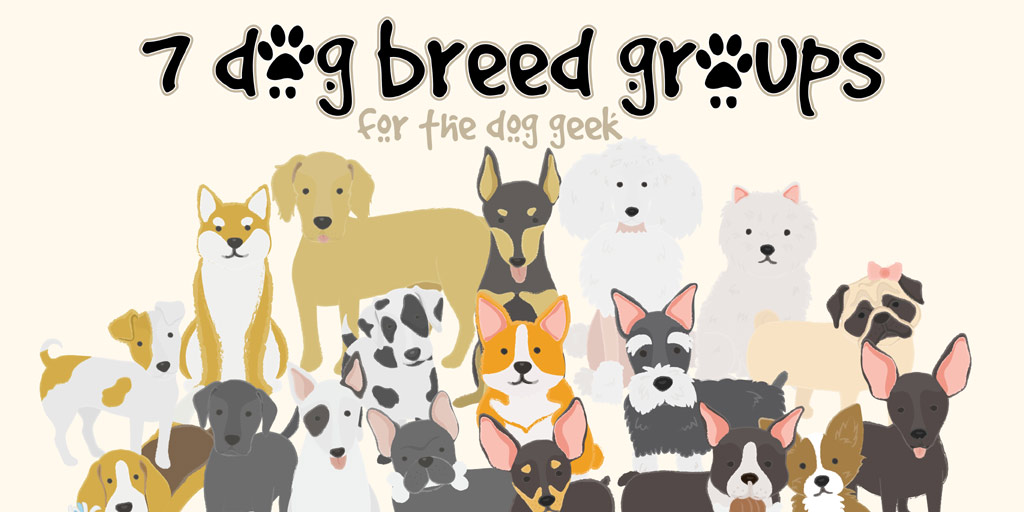7 dog breed groups for the dog geek

1. Herding
Herding dogs are bred for their ability to move herds of livestock. Although people do not always get these dogs for that specific job, the breeds will generally always have a natural tendency to be herders even if it is just herding people in their house. If you are going to have a herding dog as a house pet it is important to train them as there is a potential for danger towards small children with their instinct to herd them. Herding dogs are energetic, intelligent and easily trainable. They prefer to have a job to do so it is important to provide them with regular exercise and mental stimulation otherwise they will become restless. Popular herding dog breeds include old English sheepdogs, Australian shepherds, Corgi, German shepherd and Border collie.
2. Working
Working dogs are bred for certain jobs such as pulling sleds, guarding and rescue. They are easily trainable as they are loyal and willing to work. The size of a working dog generally ranges from medium to extra-large. There are several breeds of dogs that are classified as working dogs including Great Danes, Huskies, Rottweilers, Bernese Mountain Dogs and Mastiffs.
3. Hound
Hound dogs are often known as hunting dogs as they have an extremely strong sense of smell, stamina and a passion for hunting. Hound dogs are a. great asset to have when hunting because they will draw attention to animals with what is called “baying” or “giving tongue”. Baying is different than howling and they are both used for different situations. A hound dog often howls when they are sad, bored or lonely whereas baying is used for hunting purposes.
Some hound dogs, such as Basset hounds and beagles, have long ears that are used for picking up and retaining scents. Since they have shorter legs they do not have to stop to take in scents and they can do it with their ears. Some hound dog breeds include beagles, dachshund, Basset hound and greyhound.
4. Toy
Toy dogs are often bred for appeal and are kept as companion dogs but do not have very many practical skills. The majority of toy dogs are playful and upbeat and are very loyal to their owners. This group is made up of small dogs ranging from six pounds to 18 pounds and include Chihuahua, Maltese, Yorkshire Terrier and Pug. Toy dogs like a lot of attention and do not require exercise as frequently as larger breeds.
5. Non-Sporting
There are a number of diverse breeds in the non-sporting group including Chow Chows, French Bulldogs and Shar‑Pei. Since these dogs come in a variety of sizes, energy levels and characteristics there is not a broad description that can capture all of the breeds. Breeds that do not fit the requirements of the other groups are often put into the non‑sporting group and the majority of the time they are kept as house pets. The largest breeds in the non-sporting group include the Dalmatian and the Poodle and the smallest breeds are the Shih Tzu and Bichon Frise.
6. Sporting
Sporting dogs were first bred to be used to help hunters as they are energetic, naturally alert and have a strong ability to locate and retrieve animals. Many people have sporting dogs now as house pets but it is important that they get at least one hour of exercise every day. They are gentle and intelligent and are one of the best groups of dogs to have as a companion. Many sporting dogs are also used in service positions for people with disabilities or the law enforcement as they are easy to train. The size of sporting dogs ranges from medium to large and is made up of Spaniels, Retrievers, Pointers and Setters.
7. Terrier
Terriers range from small to medium in size and generally have short wire coats with the exception of a few breeds. They have are feisty and have an extremely high activity level which can sometimes make them more difficult to train compared to breeds in other groups. If you are planning to get a Terrier you should have a high level of patience to deal with their energetic personalities. Many terriers are inclined to dig for prey and will often dig for rats, badgers and weasels. Some of the popular terrier breeds include Miniature Schnauzers, Bull Terriers, Scottish Terriers and Irish Terriers.














